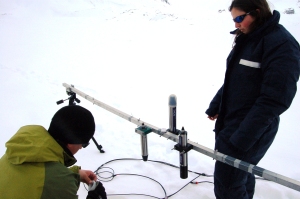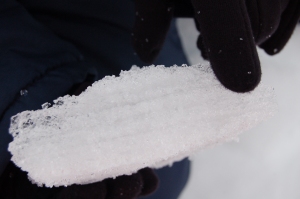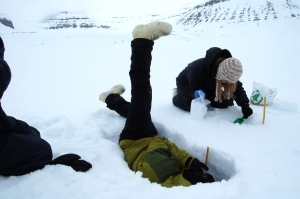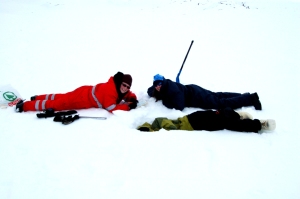
There’s no business like snow business
May 22, 2009One of the best things about coming to a place like Ny-Alesund is that it’s not just for marine biologists – there are all sorts of other scientists here, from glaciologists to meteorologists. This means that we get the chance to talk to people who are doing totally different things to ourselves, and to learn a bit about what they study. On Wednesday evening, we jumped at the chance to do some field work with a snow scientist … and not just because it meant we had to drive skidoos!
We set off for the field site after dinner. It was only about 10 minutes’ drive away by snow scooter, but even at that short distance, it felt really good to be outside in the open after a couple of weeks on base. Our first job when we arrived was to pack away the equipment that Wiley the friendly snow scientist had set up earlier in the day. This consisted of a rig-up holding three different irradiance meters; one which measures the amount of light coming from above, and two which measure the light being reflected back again by the snow. Wiley is studying the reflective properties (“albedo”) of snow, which can affect the world’s climate because light-coloured objects tend to reflect rather than absorb heat. Wiley and his colleagues are particularly interested in how soot pollution from the atmosphere affects the reflectivity of the snow once it becomes trapped between the ice crystals, and they also use small aircraft to take measures of irradiance from the air, which they can compare with their field measurements.

Wiley and Helen start to dismantle the equipment used for measuring sky- and snow- irradiance. Photo: Bonnie Laverock
Once the equipment had been packed away, it was time to dig some snow pits! Wiley had previously marked out three squares in the snow, and we dug a pit next to each of these so that we could look at a vertical section of snow going down the side of the pit. Basically, Wiley sits inside the pit and studies the layers that make up this section, particularly to look at the size and shape of the ice crystals in each layer.

A layered section of snow with fingertip for scale. Photo: Bonnie Laverock
The size and shape of the ice crystals within the snow layers affects the reflective properties of the snow as a whole. For instance, round grains of ice might reflect light in all directions, whereas more angular grains would reflect light less predictably, some of which might bounce back up, and some of which might get absorbed by deeper snow layers. The individual layers of snow are often separated by ice lenses, which absorb more light rather than reflecting it back at the sky. Wiley made a note of the type of ice crystal present at each layer, measuring the size of the crystals with a magnifying lens called a loupe, while we took notes in his field notebook. We were surprised by how many different types of snow there were!

Studying the size of ice crystals using a loupe and a millimetre-square meausuring card. Photo: Bonnie Laverock
While we were doing all of this digging and measuring, Hannah was set to work to collect the pristine snow from the three squares that Wiley had drawn earlier. The top 5 cm of snow was collected to be taken back to the laboratory for analysis of carbon content – this gives an idea for how much carbon soot is in the snow, and therefore how polluted the air was when the snow fell. It was important to be very clean when collecting this, because the carbon is present in such low amounts that it can easily be contaminated – so Wiley had marked three particularly clean areas of snow, which Hannah carefully bagged up and labelled.

Hannah carefully collects clean snow while Wiley studies the deeper layers in his snow pit. Photo: Bonnie Laverock
Finally, when everything was measured and collected, we filled in the snow pits, packed everything onto a sledge, and attached it to a snow scooter to be towed back to base. We had one final rest with some chocolate – a reward for 3 hours’ hard work as snow science field assistants – and then it was back to base for a well-earned dip in the hot tub before resuming our lives as marine biologists!

Photo: Bonnie Laverock




Leave a comment